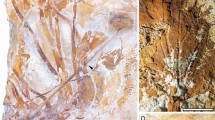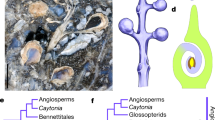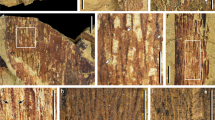Abstract
EVIDENCE for terrestrial vegetation in Ordovician and Silurian times, before the advent of vascular plants, comes from palyno-morphs (cryptospores1), that is, non-dissociating tetrads and dyads2,3 and cuticles4. The lack of a megafossil record for the spore producers is usually attributed to low fossilization potential of vegetative tissues, and this, plus spore type5, contributes to the hypothesis that the plants were embryophytes/archegoniates at a bryophyte level of organization3,5,6 and perhaps most similar in organization to modern hepatics5. Here we describe a minute coal-ified fossil from the Lower Devonian (Lochkovian: micrornatus-newportensis Spore Biozone) of the Welsh Borderland7, which contains obligate, smooth-walled tetrahedral tetrads, similar (by scanning electron microscopy) to those first recorded in the Ordovician. To our knowledge, these are the first data on the gross morphology and tissues of the plants that comprised the earliest embryophyte land flora (Gray's Eoembryophytic epoch3), albeit obtained from a relict Devonian example fossilized at a time when the composition of dispersed spore and megafossil assemblages suggests that tracheophytes and tracheophyte-like plants (rhyniophytoids) had generally begun to dominate land vegetation (Gray's Eotracheophyta3). Its anatomy in toto finds no exact parallels in embryophytes, but many of the individual cellular features match those in extant hepatics (liverworts).
This is a preview of subscription content, access via your institution
Access options
Subscribe to this journal
Receive 51 print issues and online access
$199.00 per year
only $3.90 per issue
Buy this article
- Purchase on SpringerLink
- Instant access to full article PDF
Prices may be subject to local taxes which are calculated during checkout
Similar content being viewed by others
References
Richardson, J. B., Ford, J. H. & Parker, F. J. Micropal. 3, 109–124 (1984).
Gray, J. Syst. Assoc. Spec. 44, 49–87 (1991).
Gray, J. Palaeogeogr. Palaeoclimatol. Palaeoecol. 104, 153–169 (1993).
Gray, J., Massa, D. & Boucot, A. J. Geology 10, 197–201 (1982).
Gray, J. Phil. Trans. R. Soc. B309, 167–195 (1985).
Gray, J. Spec. Pap. Pal. 32, 281–294 (1984).
Edwards, D., Fanning, U. & Richardson, J. B. Bot. J. Linn. Soc. (1994).
Schuster, R. M. New Manual of Bryology Vol. 2 (Hattori Botanical Laboratory, Nichinan, Japan, 1984).
Pocock, K. & Duckett, J. G. New Phytol. 99, 281–304 (1985).
Edwards, D., Davies, K. L. & Axe, L. Nature 357, 683–685 (1992).
Edwards, D. New Phytol. 125, 225–247 (1993).
Lang, W. H. Phil. Trans. R. Soc. B227, 245–291 (1937).
Burgess, N. D. & Edwards, D. Bot. J. Linn. Soc. 97, 189–203 (1988).
Edwards, D. Bot. J. Linn. Soc. 84, 223–256 (1982).
Burgess, N. D. & Edwards, D. Bot. J. Linn. Soc. 106, 41–66 (1991).
Niklas, K. J. & Smocovitis, V. Paleobiology 9, 126–137 (1983).
Ligrone, R. & Duckett, J. G. Ann. Bot. 73, 577–586 (1994).
Garbary, D. J., Renzaglia, K. S. & Duckett, J. G. Plant Syst. Evol. 188, 237–269 (1993).
Mischler, B. D. & Churchill, S. P. Cladistics 1, 305–328 (1985).
Mischler, B. D., Thoall, P. H., Hopple, J. S. Jr, De Luna, E. & Vilgalys, R. Bryologist 95, 172–189 (1992).
Taylor, W. A. Nature 373, 391–392 (1995).
Author information
Authors and Affiliations
Rights and permissions
About this article
Cite this article
Edwards, D., Duckett, J. & Richardson, J. Hepatic characters in the earliest land plants. Nature 374, 635–636 (1995). https://doi.org/10.1038/374635a0
Received:
Accepted:
Issue Date:
DOI: https://doi.org/10.1038/374635a0



